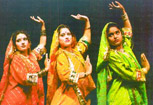Jagaran

This folk song and dance form of Jammu is based on the theme of marriage and is performed during the marriage ceremony. When the groom, accompanied by the men folk, leaves for his in-laws' house (i.e. baraat), women folk left alone at home indulge in Jagarna. The whole night is spent in gossiping and dancing, hence the name Jagarna. This is performed exclusively by womenfolk; children and men are strictly prohibited from witnessing or participating.
Such practices and ceremonies are dying out due to the fast changing lifestyle and a consciousness of modernity.


